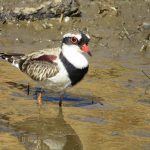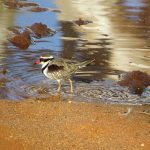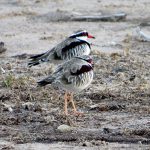BLACK-FRONTED DOTTEREL
The Black-fronted dotterel is a small, slender shorebird native to Australia. It belongs to the family Charadriidae, which includes other species of plovers and dotterels. It is a small bird measuring about 15-17 cm in length.
It has a distinctive black patch on its forehead and a white stripe above its eye. The rest of its plumage is mostly pale greyish-brown with some white on the belly and undertail coverts. During the breeding season, males may have a slightly darker plumage and a black band across their breast.
These dotterels are primarily found in Australia, where they are distributed across various regions, including parts of eastern, south-eastern, and south-western Australia. They are typically found in wetland habitats, including lakeshores, riverbanks, and estuaries.
Black-fronted dotterels are known for their distinctive foraging behavior. They often feed in shallow water, probing the mud or sand with their bills to find small aquatic invertebrates like insects, crustaceans, and worms. They are also known to feed on the edges of wetlands and sometimes in agricultural fields.
Breeding season for Black-fronted dotterels typically occurs during the austral spring and summer months (September to February). They build simple nests on the ground, often near water, using small stones and twigs. The female usually lays a clutch of 2-4 eggs, and both parents take turns incubating the eggs and caring for the chicks.
The conservation status of the black-fronted dotterel varies across its range. While the species is generally not considered globally threatened, local populations may face threats from habitat destruction and disturbance in some areas.
Black-fronted dotterels are relatively quiet birds, but they may produce soft, high-pitched calls when alarmed or during courtship displays.
These birds are fascinating examples of Australia’s diverse avian life and play a role in maintaining the ecological balance of their wetland habitats. Protecting and conserving these habitats is crucial for the continued survival of the Black-fronted dotterel and many other species of waterbirds.




